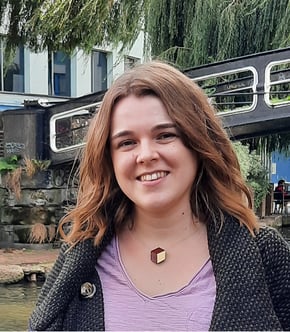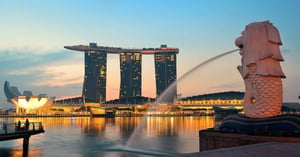March 22 marks the annual World Water Day, a United Nations observance day highlighting the importance of fresh water. It is designed to advocate for the sustainable management of freshwater resources. What does that mean for cities? And how can we establish a smart water management system?
Water smart cities treat water as a resource instead of as a nuisance. They are equipped to handle climate change consequences like droughts and severe rainfalls. Singapore is a great example for an innovative approach to freshwater management: The densely populated city-state with 6 million inhabitants has to ensure sustainable water supply during droughts, as well as effective stormwater drainage during rain seasons.
The Four National Taps
Even though it is surrounded by water, Singapore has no natural water resources. Droughts and rising demand for freshwater from a growing population means that there is pressure to provide freshwater. Despite its abundant rainy season, Singapore cannot collect a lot of freshwater because space is limited. Luckily, the Public Utilities Board of Singapore has found an innovative way of sustainably and smartly managing the city’s freshwater supply by diversifying into four water sources or “taps”. Together, they cover Singapore’s water needs of about 430 million gallons a day:
Imported Water
In the past, Singapore has been heavily reliant on imported water from Malaysia. Two agreements regulate this relationship, one from 1962 and one from 1990. Both will expire in 2061. The 1962 agreement stipulates the price of raw water and entitles Singapore to receive up to 250 million gallons of water per day. In 2011, this was the equivalent of 56% of Singapore’s water use. The 1990 agreement entitles Singapore to buy additional unspecified quantities of treated water at a higher price.
NEWater
Five water reclamation plants and four factories in Singapore produce NEWater, reclaimed water from wastewater. This water covers up to 40% of daily demand, although most of it is used in the high-tech industry. Only a small amount of reclaimed water is bottled drinking water. The purification facilities are highly advanced, which means that NEWater exceeds all WHO standards for drinking water. It enjoys a high acceptance rate from Singaporeans, 82% of whom would drink it directly. 16% of them prefer NEWater to be mixed with reservoir water.
Desalinated water
Seawater desalination as a freshwater source is an attractive option for any city close to the ocean. Officially, Singapore. In 2005, the city opened its first desalination plant, which provides about 10% of its freshwater supply from desalinated water . By April 2022, five desalination plants were under operation. Together, they can meet up to 30% of the city’s water needs, according to PUB.
Rainwater collection
Annual rainfall in Singapore is 2,400 mm, more than double the global average of 1,050 mm. Land to catch and store the abundant tropical rainwater is limited, but artificial reservoirs can collect up to 200 - 300 million gallons of water per day. Carefully managed catchment areas now make up around two-thirds of Singapore’s area. PUB plans to increase the water catchment to 90% of the city-state’s land area. Most of the catchments are in the Central Catchment Nature Reserve of Singapore, a protected and reforested area that also serves as a green lung for the city. River estuaries house further reservoirs for water catchment, as do countless rooftops.
Water self-sufficiency
Singapore has the goal of becoming fully water self-sufficient as early as possible. The deadline for this is the year 2061, when the second contract for water import with Malaysia will expire. In the future, the city-state aims to provide 85% of its freshwater through desalination and recycled NEWater. The remaining 15% will come from local catchments and, where necessary, from imported water. Considering that by 2060, total water demand could almost double, this is an even more impressive feat.
PUB’s Smart Water Grid system includes sensors and analytic tools all over the island. Much like other smart city infrastructure, these help to provide real-time monitoring and data collection, supporting decisions and enabling PUB to manage the water supply network efficiently.
Even a very well-thought-out water management system can collapse in extreme weather events. Here, too, Singapore is ahead of many other cities: Its stormwater drainage system is completely separated from the city’s sewer system. Public roadside drains, canals and waterways help to reduce flood-prone areas. In the 1970s, about 3,200 hectares of land in Singapore experienced frequent flooding. Today, despite increased urbanisation, that number stands only at 49 hectares, according to PUB. While flash floods can still cause damage and blocked drains, a smart water management system can prevent the worst.
Aside from strategies for freshwater provision and stormwater drainage, the example of Singapore also shows another element of smart water management: Water conservation and efficiency. The city has a goal of lowering consumption to 140 litres per person per day by 2030. In 2003, 165 litres of water per person were consumed. Measures like a Water Efficiency Labelling Scheme for taps, showerheads, and other appliances were introduced. In addition, water prices became higher. This has resulted in very low water losses and reduced water consumption.
Lessons from a water smart city
Singapore showcases that a multi-pronged water strategy is a smart approach for providing freshwater in a city with limited space. While the discharge of treated, used water into the sea is problematic, Singapore’s strategy is still very sustainable. Currently, it looks like the city will meet its goal of becoming water self-sufficient sooner than expected. Challenges will include increasing water demand, a need for more efficient innovative technologies, and the automation of as many tasks as possible.
Of course, Singapore is a wealthy city with unique geographic conditions. But there are important lessons to be learnt from its smart and resilient water management. Most importantly, these key lessons could inspire other cities:
- Collect every drop of water.
- Reuse water endlessly by recycling it.
- Desalinate more seawater.
Find out more about smart water management and other smart city solutions in our global solutions database. Get FREE access to hundreds of SMART CITY SOLUTIONS that have been implemented successfully in over 1,000 cities around the world. Join the leading global smart city network and community!


